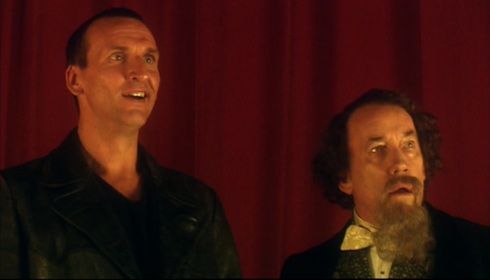After, aliens, spaceships, time travel, and serious and artful mediations on the human condition, there’s almost nothing science fiction and fantasy enjoys more than a good allusion to literature. Nicholas Meyer brought a bunch of Dickens, Melville, Doyle, and Shakespeare to Star Trek, while more contemporary steampunk science fiction, like Lev Rosen’s All Men of Genius has its roots in Twelfth Night and Oscar Wilde. Meanwhile, the forthcoming film, The Raven sees Edgar Allan Poe himself as central character in a creepy murder mystery. Arguably the most famous and outlandish science fiction film of all time, Forbidden Planet delivered not only a flying saucer and a talking robot, but derived its storyline from The Tempest. Pretty highbrow stuff for a sometimes “trashy” genre!
Occasionally this literary reference goes an extra step. Sometimes famous authors themselves appear as characters in works of science fiction. Here’s a smattering of some of the instances we discovered.
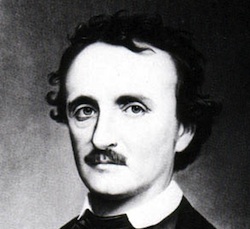 Before he became John Cusack, Edgar Allan Poe used to live on Mars. In Ray Bradbury’s The Illustrated Man there is a story called “The Exiles” in which the likes of Poe, Ambrose Bierce, Algernon Blackwood, and Charles Dickens are living on Mars because the people of Earth have stopped believing in them. There’s a faint hint that this story takes place in the same universe of Fahrenheit 451 since the mentions of book burnings are numerous. Bradbury also has a story called “G.B.S.-Mark V” where George Bernard Shaw shows up as a robot.
Before he became John Cusack, Edgar Allan Poe used to live on Mars. In Ray Bradbury’s The Illustrated Man there is a story called “The Exiles” in which the likes of Poe, Ambrose Bierce, Algernon Blackwood, and Charles Dickens are living on Mars because the people of Earth have stopped believing in them. There’s a faint hint that this story takes place in the same universe of Fahrenheit 451 since the mentions of book burnings are numerous. Bradbury also has a story called “G.B.S.-Mark V” where George Bernard Shaw shows up as a robot.
Charles Dickens crops up again in the Dan Simmons novel Drood where a shadowy figure which gives the book its title messes around with poor Charlie. Though not specifically science fiction, Simmons is known for his SF books like Hyperion that does feature poet John Keats as a character. But if we’re sticking with Dickens, the most recent and very science fiction appearance of him as a character is in Doctor Who. First in the Mark Gatiss penned-episode “The Unquiet Dead” and then more recently (albeit) briefly in “The Wedding of River Song.” The Unquiet Dead” is nice because it give us an explanation for where Dickens got his ideas about ghosts. (Picture of Dickens and the 9th Doctor at the top of the post)
Not all authors in science fiction adventures have to be assisted by science fiction characters, sometimes the authors themselves take center stage. This is true in the book Blake’s Progress by R.F. Nelson where the poet William Blake and his wife Catherine embark on a series of inter-time and cross-dimensional adventures. The short-lived television show The Secret Adventures of Jules Verne naturally operated on a similar premise, giving us the exciting steampunky adventures of not only Verne (Chris Demetral) but also the occasional appearance of Alexandre Dumas (John Rhys-Davies)
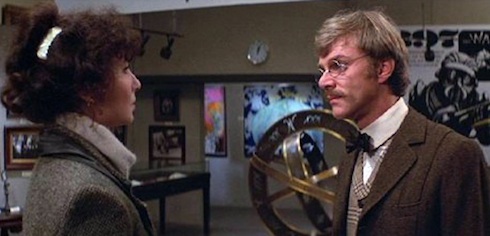
Similarly, the often-forgotten Nicholas Meyer film Time After Time portrays H.G. Wells (Malcolm MacDowell) as its primary protagonist as he journeys through time and space to a 1970s San Francisco where he is determined to stop Jack the Ripper (David Warner) from ripping up 20th century America. Other than featuring a literary figure as its main character, this science fiction movie is also notable because Mary Steenburgen plays the loves interest of H.G. Wells, making it the first of two occasions in which she plays the girlfriend of a time traveler. (The other being Back to the Future III.) When you think about it, it’s shocking that Steenburgen didn’t have some kind of role in the film version of The Time Traveler’s Wife!
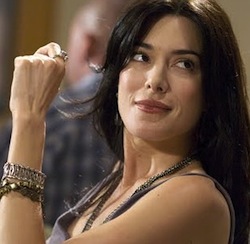 But back to good old H.G. for a moment. Wells also appears in the Colin Baker era DoctorWho episode “Timelash” as well as four episodes of Lois & Clark: The New Adventures of Superman. And of course Warehouse 13 features a character named Helena G. Wells who is revealed to be the science fiction writer truly responsible for all those famous novels, while her famous brother “Charles” was merely the front.
But back to good old H.G. for a moment. Wells also appears in the Colin Baker era DoctorWho episode “Timelash” as well as four episodes of Lois & Clark: The New Adventures of Superman. And of course Warehouse 13 features a character named Helena G. Wells who is revealed to be the science fiction writer truly responsible for all those famous novels, while her famous brother “Charles” was merely the front.
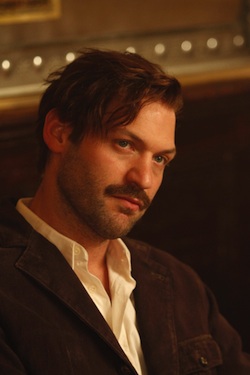 Of course no literary reference discussion would be complete without an inclusion of Ernest Hemingway. Hemingway appears in the form of numerous android duplicates in the short story “Papa’s Planet” by William F. Nolan. This planet is a sort of Hemingway amusement park with various versions of the author manifested in different robot forms. The narrator also loses his love interest to a simulacrum of F. Scott Fitzgerald! Hemingway also is central to the Joe Haldeman novella The Hemingway Hoax in which an academic attempts to create a false “lost” Hemingway manuscript only to be confronted with a sort of multiverse cop which advises him not to create such a piece. This multiverse cop looks just like Hemingway and repeatedly kills the protagonist over and over again, constantly sending him into alternate realities.
Of course no literary reference discussion would be complete without an inclusion of Ernest Hemingway. Hemingway appears in the form of numerous android duplicates in the short story “Papa’s Planet” by William F. Nolan. This planet is a sort of Hemingway amusement park with various versions of the author manifested in different robot forms. The narrator also loses his love interest to a simulacrum of F. Scott Fitzgerald! Hemingway also is central to the Joe Haldeman novella The Hemingway Hoax in which an academic attempts to create a false “lost” Hemingway manuscript only to be confronted with a sort of multiverse cop which advises him not to create such a piece. This multiverse cop looks just like Hemingway and repeatedly kills the protagonist over and over again, constantly sending him into alternate realities.
Though not totally SF, Hemingway naturally hung out with Indiana Jones in several episodes of The Young Indiana Jones Chronicles. And Hemingway recently made appearance (along with Fitzgerald, Gertrude Stein, and others) in the Woody Allen time travel comedy Midnight in Paris.
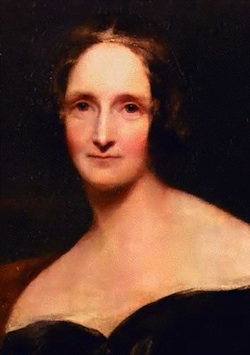 The mother of perhaps all of science fiction, Mary Shelley makes an appearance as a character in a few science fiction narratives, too. Interestingly enough, Mary Shelley is used as a framing mechanism for the film 1935 film The Bride of Frankenstein. Elsa Lanchester portrayed Mary Shelley in this film, but also interestingly played “the monster’s bride!” Mary Shelley (Tracy Keating) also crosses paths with that sword-swinging immortal Duncan Macleod in the Highlander series episode called “The Modern Prometheus.” This title was of course, a reference to the alternate title of Frankenstein.
The mother of perhaps all of science fiction, Mary Shelley makes an appearance as a character in a few science fiction narratives, too. Interestingly enough, Mary Shelley is used as a framing mechanism for the film 1935 film The Bride of Frankenstein. Elsa Lanchester portrayed Mary Shelley in this film, but also interestingly played “the monster’s bride!” Mary Shelley (Tracy Keating) also crosses paths with that sword-swinging immortal Duncan Macleod in the Highlander series episode called “The Modern Prometheus.” This title was of course, a reference to the alternate title of Frankenstein.
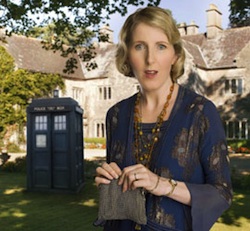 When writers show up in fanciful narratives, often the story takes on the form of the kind of story you’d associate with that writer. (As was the case in the Dickens Who episode.) In another Doctor Who episode, the real-life disappearance of Agatha Christie was “explained” by showing that Agatha Christie had her memory erased by aliens. In terms of an author interacting with a science fiction premise in a TV show, this little alien whodunit has to be one of the most entertaining.
When writers show up in fanciful narratives, often the story takes on the form of the kind of story you’d associate with that writer. (As was the case in the Dickens Who episode.) In another Doctor Who episode, the real-life disappearance of Agatha Christie was “explained” by showing that Agatha Christie had her memory erased by aliens. In terms of an author interacting with a science fiction premise in a TV show, this little alien whodunit has to be one of the most entertaining.
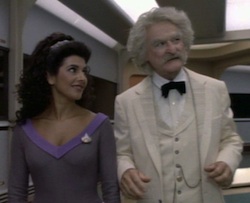 “Time’s Arrow,” the Star Trek: The Next Generation episode featuring Mark Twain AND Jack London has pretty much nothing in common with the writings of either author. Though Mark Twain getting taken aboard the Enterprise is pretty sweet. (In retrospect it almost seems like it would have been more fitting if his literary doppelganger Kurt Vonnegut were instead given a tour of the ship.) Jack London is a bellhop in this one, and we don’t even know he’s Jack London until the end.
“Time’s Arrow,” the Star Trek: The Next Generation episode featuring Mark Twain AND Jack London has pretty much nothing in common with the writings of either author. Though Mark Twain getting taken aboard the Enterprise is pretty sweet. (In retrospect it almost seems like it would have been more fitting if his literary doppelganger Kurt Vonnegut were instead given a tour of the ship.) Jack London is a bellhop in this one, and we don’t even know he’s Jack London until the end.
In terms of the identity of a writer being kept a secret for an entire story, only to be revealed at the end, the Quantum Leap episode “The Boogieman” takes the prize there. In this uber-spooky story, Sam discovers at the end of the episode that he’s been hanging out with none other than Stephen King! The episode also has loads of King references, paradoxically explaining where all of King’s good ideas came from.
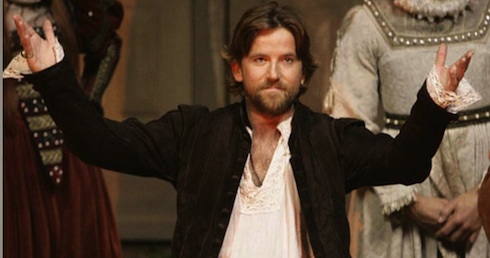
The bard himself, William Shakespeare has of course made his mark on science fiction. Again, the good Doctor gave him some writing pointers in Doctor Who’s “The Shakespeare Code.” Shakespeare is also featured in the classic Twilight Zone episode “The Bard.” The Goblin Reservation by Clifford Simak also features William Shakespeare being brought into a future world. However, it seems odd that though Shakespearean references are strewn throughout science fiction that Will himself isn’t more present in as a character in different stories. Perhaps there is a science fiction narrative all about him that I’m unaware of.
What about you well-read readers? What other noted authors have made appearances in science fiction narratives?
Ryan Britt is the staff writer for Tor.com. To date, he has written three science fiction short stories featuring famous authors; “The Hemingway Escape,” “Weeping Woody,” and “The Joyce of Sex” none of which have (yet) been published.










